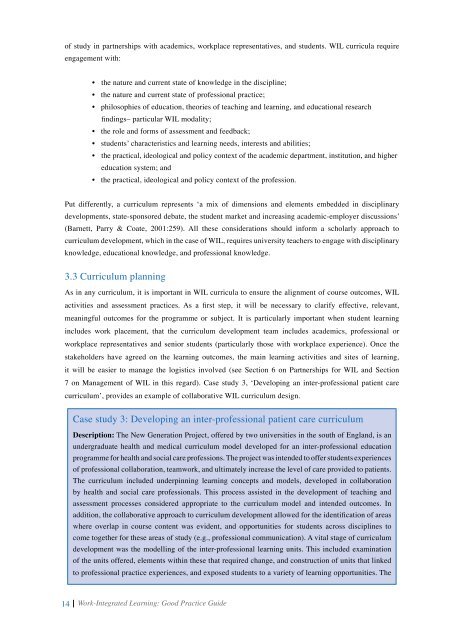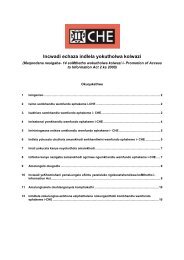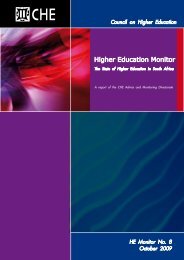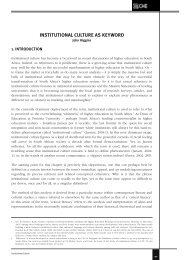Work-Integrated Learning: Good Practice Guide - CHE
Work-Integrated Learning: Good Practice Guide - CHE
Work-Integrated Learning: Good Practice Guide - CHE
Create successful ePaper yourself
Turn your PDF publications into a flip-book with our unique Google optimized e-Paper software.
of study in partnerships with academics, workplace representatives, and students. WIL curricula require<br />
engagement with:<br />
14<br />
• the nature and current state of knowledge in the discipline;<br />
• the nature and current state of professional practice;<br />
• philosophies of education, theories of teaching and learning, and educational research<br />
findings– particular WIL modality;<br />
• the role and forms of assessment and feedback;<br />
• students’ characteristics and learning needs, interests and abilities;<br />
• the practical, ideological and policy context of the academic department, institution, and higher<br />
education system; and<br />
• the practical, ideological and policy context of the profession.<br />
Put differently, a curriculum represents ‘a mix of dimensions and elements embedded in disciplinary<br />
developments, state-sponsored debate, the student market and increasing academic-employer discussions’<br />
(Barnett, Parry & coate, 2001:259). All these considerations should inform a scholarly approach to<br />
curriculum development, which in the case of WIL, requires university teachers to engage with disciplinary<br />
knowledge, educational knowledge, and professional knowledge.<br />
3.3 curriculum planning<br />
As in any curriculum, it is important in WIL curricula to ensure the alignment of course outcomes, WIL<br />
activities and assessment practices. As a first step, it will be necessary to clarify effective, relevant,<br />
meaningful outcomes for the programme or subject. It is particularly important when student learning<br />
includes work placement, that the curriculum development team includes academics, professional or<br />
workplace representatives and senior students (particularly those with workplace experience). once the<br />
stakeholders have agreed on the learning outcomes, the main learning activities and sites of learning,<br />
it will be easier to manage the logistics involved (see Section 6 on Partnerships for WIL and Section<br />
7 on Management of WIL in this regard). case study 3, ‘developing an inter-professional patient care<br />
curriculum’, provides an example of collaborative WIL curriculum design.<br />
case study 3: developing an inter-professional patient care curriculum<br />
Description: the New generation Project, offered by two universities in the south of England, is an<br />
undergraduate health and medical curriculum model developed for an inter-professional education<br />
programme for health and social care professions. the project was intended to offer students experiences<br />
of professional collaboration, teamwork, and ultimately increase the level of care provided to patients.<br />
the curriculum included underpinning learning concepts and models, developed in collaboration<br />
by health and social care professionals. this process assisted in the development of teaching and<br />
assessment processes considered appropriate to the curriculum model and intended outcomes. In<br />
addition, the collaborative approach to curriculum development allowed for the identification of areas<br />
where overlap in course content was evident, and opportunities for students across disciplines to<br />
come together for these areas of study (e.g., professional communication). A vital stage of curriculum<br />
development was the modelling of the inter-professional learning units. this included examination<br />
of the units offered, elements within these that required change, and construction of units that linked<br />
to professional practice experiences, and exposed students to a variety of learning opportunities. the<br />
<strong>Work</strong>-<strong>Integrated</strong> <strong>Learning</strong>: <strong>Good</strong> <strong>Practice</strong> <strong>Guide</strong>






